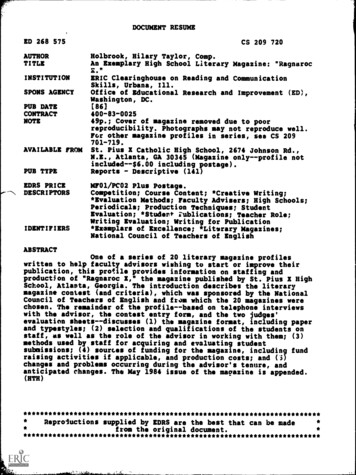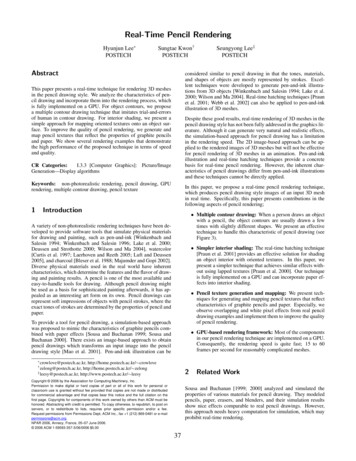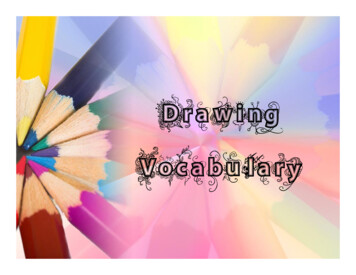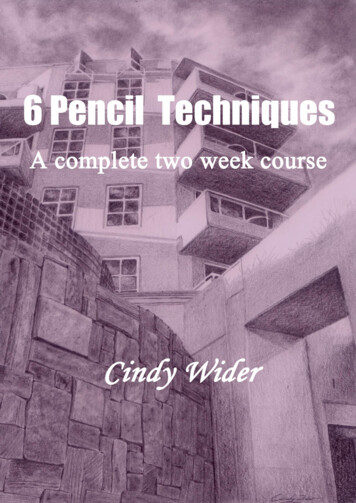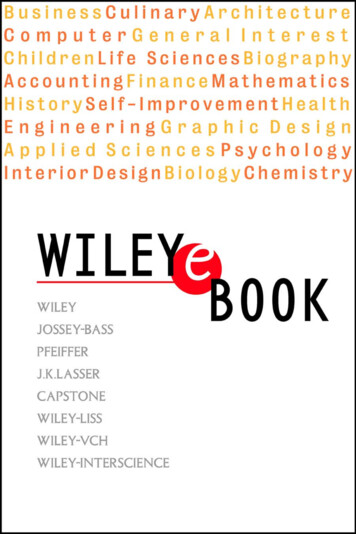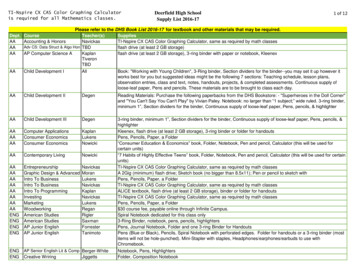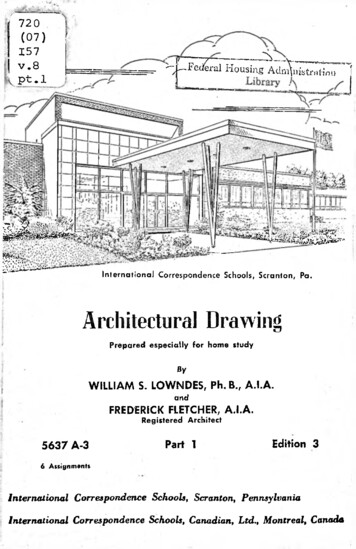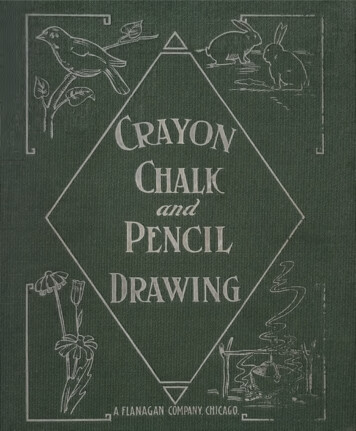
Transcription
Copyright N COPYRIGHT DEPOSIT.
ft
t
LVf ,«i'’ r *.- ’ l‘- x "' ' '-:V-‘.m -5,-v ;iliSHdl
1CRAYON, CHALK, ANDPENCIL DRAWINGBYGERTRUDE L. CLAYTONiiOVER SIXTY STUDIES WITH SIX FULLPAGES IN COLORA. FLANAGAN COMPANYCHICAGO
Copyright 1911BYA. FLANAGAN COMPANYC Cl. A 2 S 0 S 7 0
3INTRODUCTIONThis book is planned for several purposes, the chief of which is to givesuggestions for drawings that the children can work from the studies con tained herein.They may do this in several ways:without variation;First, by directly copyingsecondly, by using these as material for compositionsof their own—most valuable practice; thirdly, by applying the suggestionsgiven, in drawing other similar things from nature.The majority of the drawings found here are sufficiently simple in theirplan for the youngest child in school.At the same time they are just aspractical for a'much older child.In teaching the small child details should be forgotten and the big simpledirect facts expressed.As the child progresses in power of expression hisdrawings become more accurate because his power of observation increases.The principles involved in each drawing can be dealt with more or less fullyaccording, to the age and previous training of the pupil.The child should be encouraged to collect good drawings—reproductionsof photographs, etc.—from all sources as material for use in compositionsand designs.He should be urged to use every opportunity to study theshapes of all plant and animal life available.His attempts to express inrdrawings his observations will encourage closer and more accurate study.For that reason drawing is an invaluable aid in nature study.
GENERAL DISCUSSION
CRAYON, CHALK, AND PENCILDRAWINGGENERAL DISCUSSIONIn its most general sense crayon drawing includes work with chalk,charcoal, and wax crayon.These are the easiest mediums through which a child can attempt toexpress his ideas. They are soft, therefore every stroke tells; they areespecially adapted to broad, big work, and at the same time can in skilledhands suggest all necessary detail.The technique of the material doesnot interfere, as in water-color work, with the freedom of expression.Methods of Using Colored Chalk.colored chalk:—(1)The Rubbed Method.There are two methods of usingThe color is rubbed into the paper with thefingers, a soft cloth, or a stomp. In this method it is best to sketch thedrawing in lightly in outline, with chalk or charcoal, then put in theshadows. Work from the darkest parts toward the lighter, rubbing thecolors into one another. Work one color over the other, to get the desiredcolor and tone.Edges should be softened wherever indefinite effects aredesired.This method allows a child to work over and correct a study as longas he can see anything to correct.value, and shape of masses.It is especially good for securing tone,If it is badly handled, however, the result is adirty, muddy study which is very unattractive.(2)The Line Method.In the second method, which is the one fol lowed in the directions for working up the later studies, the color is put onwith the point of the chalk or crayon.The surface is not rubbed.and the texture of the paper are allowed to show in part.The colorThe colors aremodified by working one lightly over or by the side of another.This method produces a fresher, cleaner, clearer effect than the first.
8CRAYON, CHALK AND PENCIL DRAWINGSpraying.To preserve chalk drawings spray themwith fixative.Enough fixative for the whole room can be made very cheaply by dis solving in wood alcohol as much powdered white shellac as the alcohol willtake up.A fixative sprayer may be bought for 15 or 25 cents.Put the smallend of the sprayer in the bottle of fixative, bend the joint to a right angleor a little less than a right angle, and blow with a long, steady breaththrough the large end of the second tube.The spray will come from theupper end of the small tube, which is in the bottle.The spray must be held far enough away from the drawing so thatonly a fine mist covers the latter.sketch.Wax Crayons.If it is held too close it will spot theThe various kinds of wax crayon are cleaner tohandle than the chalks. The drawings do not require spraying. Waxcrayon can also be used in coloring designs for which the chalk is notadapted.Handling of Crayon.Since crayon work is closely related to watercolor, it is convenient in discussing it to use a few expressions generallyapplied to water-color work. Before attempting a study let the child makea few experimental sheets, to learn how best to handle the crayon.Thesemight be worked up as rug designs.First, hold the crayon loosely under the palm of the hand, with a broadsurface next the paper. Beginning at the top of the sheet, stroke hori zontally across.Do this slowly enough to produce an even surface.Fillthe page. Let us call this a plain or Hat zvash.Now, try a wash of graded intensity, beginning with a heavy strokeat the top of the page and lightening toward the bottom; then reverse theprocess, making the heavy tone at the bottom.To secure a very dark tone it will be necessary to go over the surfaceseveral times, rubbing quite hard.For the sharper strokes on trees, etc.,hold the crayon like a pencil.Next, have the child experiment, to find the effect of one color overanother.Crayon Technique.The direction and character of the stroke must
GENERAL DISCUSSION9be studied. At first we may be content to accept flat washes for allsurfaces, but later we shall feel we need more interesting handling.A vertical stroke may help suggest a vertical surface, a horizontal or acurved stroke a corresponding surface. An irregular or broken stroke willhelp secure corresponding surface effects.In suggesting water use a horizontal stroke for the surface and a ver tical stroke for the depth. The soft, fluffy down of the chicken needs adifferent handling of the crayon from the smooth, clean-cut edge of thecherry.Study the best kind of stroke to use in different types of foliage. Avertical stroke can be used in the poplar, a slant or a rounded stroke forthe oak, a slant or a horizontal for the evergreen. Try different methodsfor the same tree and use the one that seems to suggest best the mannerof growth.In landscapes the distant trees and ground should be made withhorizontal strokes entirely.The foreground may have the undertone laid on with horizontal strokes.The sharper strokes necessary to bring out the details, such as grass, weeds,stones, and shadows, should be put in above this.Or the foreground may be worked entirely with vertical strokes as inPlate XXXIV.Studies in ColorBlending.Draw nine rectangles about l"xlj4".Take blue as abasis for this series and fill each rectangle with a wash of blue.Leave thefirst as it is; over the second wash red; over the third orange; then, inorder, yellow, green, violet, brown, and black.If the child is sufficientlyskillful he can grade the wash in each rectangle, beginning with a strongblue and lightening toward the bottom, then do the same with the colorused over it.Try each one of the colors in the same way.If time allows, experiment with washes of three colors.The result of these mixtures will vary somewhat with the quantity ofeach color used.
10CRAYON, CHALK AND PENCIL DRAWINGA color wheel like the illustration is useful for reference, even if timedoes not permit each child to make one. With the color wheel hangingin a convenient place for reference the child can always pick out his har monizing and complementary colors.We refer to red, blue, and yellow as the primary colors, and to orange,green, and violet as the secondary, because we are able with the first threepigments to produce, by mixing, the second group.By reference to the color wheel we see that the colors found at oppo site points of the diameters have the power to make each other appearmore vivid when used together. These are the complementary colors—redand green, blue and orange, etc.Color is modified in several ways. We may lighten by using the purecolor but less of it; in other words, by decreasing its intensity.We securea series of tones ranging from the full strength or intensity down to avery pale wash of the same color. This gives us a tint of the color.We may add gray to modify the pure color. In this way we secureshades of the original color. These shades may vary in intensity from thevery lightest to the very darkest possible.We may modify a pure color by adding varying proportions of anothercolor. This modified color may be used of any intensity desired.also be modified with gray as desired.It mayIf this does not seem clear after being merely read, a little experimentalwork will make it so.Take any color—red, for illustration. Starting with full strength orintensity, lighten gradually to the faintest possible tint, thus working outa scale of the tints of red.Take red in the same way and mix with gray, using equal parts of redand gray for the middle spot. Above this let the gray predominate moreand more, until at last you have a pure gray or black. Below the middlelet the proportion of red become greater and greater until the lower partis pure red. This gives a scale of shades of red.Warm and Cold Colors. While we are considering color anothergrouping into warm and cold colors presents itself.Red, orange, and yellow are the warm, green, blue, and violet the cold
GENERAL DISCUSSIONcolors.light.Red is the warmest, blue the coldest.11Yellow contains the mostIn a picture the warm colors suggest to us nearness and light.cooler colors suggest distance and shadow.TheWhenever we wish to secure the effect of shadow or distance, as inan object whose own or local color is, for instance, red, we must modifythat red and push it back by mixing with it some cooler color.In the same way an object whose local color is cool may be made toseem near and in the sunlight by using one of the warm colors over itor mixing a warm color with it.Green foliage that is near at hand andin the sunlight will have a large amount of yellow with the green.As all greens are mixtures of blue and yellow, the degree of warmthor coolness depends upon the amount of each one used.The greater theproportion of blue, the cooler the green will be; the greater the amountof yellow, the warmer the green.With violet, which is a mixture of redand blue, the same principle holds true, and we may have violet of varyingdegrees of warmth or of coolness.Fundamental Principles.A few fundamental principles of colorharmony make it possible for any person to secure color schemes whichare good.A fine feeling for color is, of course, secured only by experience.Bad combinations, however, are absolutely unnecessary.(1)We may use different tones of the same color.This can be donein two ways:—(a) By using different degrees of intensity of the samecolor,(b) By using different amounts of gray with the chosen color.In the first we simply vary the strength or intensity of the color in thewash, combining perhaps three intensities of the same color.In the second we mix perhaps a small amount of gray for the firsttone, a little more for the next, and still more for the third, obtaining threeintensities of the same color.This gives a one-color harmony which is always pleasing and easilymanaged, though sometime a little monotonous.(2)Related Harmony.By referring to the color wheel we see thatcertain colors are related.These may be used together satisfactorily,making a related harmony.For instance, blue, bluish violet, and bluish
12CRAYON, CHALK AND PENCIL DRAWINGgreen have the common factor blue.In using such a color scheme we wouldgenerally add gray as a fourth color.Any other group of related colors will be found satisfactory, such asbrown containing considerable yellow; orange, and yellow.If a fourthcolor is added a gray green containing yellow will harmonize. In thisyellow runs through the whole scheme.(3) Complementary Harmony. The colors which are directly oppo site each other on the color wheel are complements.They have thepower of making each other appear more vivid. A complementary har mony is more difficult to manage successfully. If we take red and green,which are complements, a small amount of red may be used with a largeramount of green and with a third color made by mixing red and green.Red and green may be harmonized by putting a wash of green overthe red in crayons or by mixing red with the green, and by putting a washof red over the green.This modifies both the red and the green in such a way that with agray made by an equal mixture of red and green a group of three harmon izing colors will be secured.Blue and its complement orange are harmonized by the same method.Use the wash of orange over the blue and the wash of blue over orange.Mix the two equally for the neutral color.(4) Dominant Harmony. The fourth and last principle is that ofdominant harmony. This is one of the most important.In this we find one color entering into every other color used anddominating it so that the general effect is of this one color first modifiedby various other colors.This is the element that gives the characteristiccolor to the different seasons and to the different atmospheric effects.Line Drawing Inlinedrawing we may use any of the mediums such as crayon,chalk, charcoal, or pencil.The finer and more exact work requires pencil;while the other mediums are better adapted to larger, broader work.dren need to be trained first to secure the larger, freer style of work.Chil For
Red & GreenViolet & Oranqe
:\’ ,I'*«VI.*- v"C'
GENERAL DISCUSSION13this, crayon, chalk, and charcoal are by far the best mediums.Thereforeit is well to reserve pencil work for those who have passed beyond theelementary stages of work.In line drawing, also, we must translate, as it were, the masses of lightand shade into lines.solid objects.We must see edges of dark and light as well as ofThis study of edges has a tendency to involve more detailthan mass drawing.When we wish to make a detailed study of a leaf ora flower for a design we must first block in.Proportion.Before blocking in, notice the proportion of the differ ent parts—length and width.It may be a help to indicate these on thepaper with short dashes.Next, get the direction of the long lines.Draw them in with eithera straight or a curved line, as seems more suitable for the given object.Blocking.In this blocking we must consider first the main propor tions, ignoring everything else.Connect prominent points with the blockinglines.Use a .soft, light line.in a flat, wedge-shaped point.Keep the crayon or charcoal well sharpenedA pencil need not be so sharp for the block ing lines but must have a long enough point to allow the child to direct itwell.After the object is blocked in, erase the blocking lines until they showonly faintly.Correct the proportion and add whatever details are con sidered essential.Shading.If it is necessary, erase again and work over as before.Before beginning to shade, go over the lines with aneraser till they are barely visible.If the object is to be shaded entirely theoutline will not show at all in the finished drawing.If the drawing isto be finished as a shaded outline, go over the faint outline which remainsafter erasing, accenting the parts in shadow, and as a result those leftlight will appear in relief.Methods. In shading objects we have our choice of several methodsof putting on the color:—(i)We may use a stroke at an angle of about forty-five degrees,slanting downward and toward the left.they join avoid dark streaks.Keep the lines parallel.Where
CRAYON, CHALK AND PENCIL DRAWING14(2)Lines may be used parallel to the surface of the object.Inthis method a vertical surface would be shown by vertical lines, a hori*zontal by horizontal lines.The lines used for a curved surface would showthe direction of the curve.(3)If a chalk or charcoal drawing is to be rubbed, it is better to putthe strokes in vertically.Unduly dark or hard strokes must be avoided evenif the work is to be rubbed afterward.The quality of line used in outline work is of first importance.Itmust express as much as possible the surface, represented whether it ishard or soft, smooth or rough, etc.Mechanical helps, in measuring proportion of parts, are good tohelp train the eye but only for that and should not be depended upon toomuch.To measure hold a pencil at arm’s length, close one eye, and slidethe thumb along the pencil until the height is measured off as exactly aspossible.Keep the arm fully extended and turn the pencil in such a way as tomeasure off the width.Compare the two.The pencil must be kept exactly vertical or exactly in a plane parallelto the body.The direction of lines and angles can be measured similarly.Turnthe pencil or crayon carefully, so that it seems to cover the line required.Hold the paper vertically.changing its direction.Bring the crayon down to the paper withoutThis will give the required angle or line ofdirection.To obtain a correct result, it is necessary in doing this to be carefulto turn the crayon only in a plane parallel to the worker.Imagine the pen cil is held against a pane of glass which is exactly parallel to the persondrawing.LandscapesIn landscape painting, whether with crayon or water colors, we haveseveral general points to consider before beginning actual work.First, the general or dominant color.This is regulated by the seasonof the year, the locality, the time of day, and the condition of the weather.
GENERAL DISCUSSION15The chosen conditions and resultant color scheme should be plannedbefore the sketch is begun.In the spring we have the pale yellow-green foliage, and the red, purple,and brown of twigs and trees; and generally a lighter sky than we findlater.As summer advances, the colors deepen and darken. The yellows aremore yellow, the greens more vivid, and the blue deeper. Because ofthicker foliage the shadows are darker.In the early fall we have the reds, greens, yellows, and browns. Thedistance is a hazy blue or purple. Later, the brown and ocher colorspredominate.In winter the distance is generally quite gray; the earth, trees, etc.,brownish. The snow gives us blue shadows.Let the child himself notice the dominant color schemes of his localityand of the different times of day.The weather gives a delightful variety in our landscape study. Arainy day puts a bluish mist between us and all objects. A gray day softensall the colors and blends the shadows.The varieties of trees need to be studied with reference to their individ ual color as well as their shape and manner of growth. We have thesilvery gray cottonwood, poplars, and sycamores with their light trunks;the stronger, brighter greens of the great mass of our trees, including themaple; and, last, the dark tone of the evergreens.In nature we do not find an object of one flat color.We know a treeis green, but we see that in the sunlight it is a yellow green and in theshadow a bluish green.In the same way we see a variety of color in the foreground, to securewhich we must use touches of as many colors as necessary. We may usebrown, green, yellow, and blue (very sparingly) ; or green with red, orangeand vellow.Be careful in using many colors to keep the dominant colorstrong and clear above all the others.In a child’s first efforts in landscape we are satisfied to secure a care fully laid wash of one color for sky and another for ground.When workingwith older children, however, we may use a wash of yellow, violet, or gray
16CRAYON, CHALK AND PENCIL DRAWINGwith the blue of the sky, to vary the effect.The wash of the sky color maybe brought down over the distant trees, to avoid sharp edge lines there.In coloring skies avoid too intense a blue.The stick should be usedvery lightly.At first a road may be put in as brown. Later, yellow may be workedinto the foreground. Blue or violet may be used for the shadows cast bystrong sunshine. Shadows cast on the snow are distinctly bluish and quiteclear.The shaded side of the tree is made with either black and blue overgreen or, better, red and blue over the green mass of foliage. A warmshadow is produced if red is the last color used. If blue or green is theupper color the result is a cool shadow. As shadows are generally cool,it is best to let the blue or the green predominate.Trunks of trees are made with either brown and green or—in the caseof lighter-colored trunks such as those of the sycamore and the birch— yellow and gray or brown.Landscape Composition.Since the success of a landscape sketchdepends largely upon the arrangement of the parts, it is well to considerthe general principles that concern composition.The first of these is balance.We must divide our space first by thesky line, then by the edges of the big masses, in such a way as to secure agood proportion between sky and ground and between these and the massesof trees or other objects of which the landscape is composed; in other words,so that the masses balance. The masses of the foliage should be put inwith no meaningless irregularities and breaks; the masses of light andshade kept as large and simple as possible. Notice how exceedingly flatand big the masses are in the moonlight.The spacing of the vertical lines of the composition must be planned.An irregular spacing is more attractive than a measure that is as easilygrasped by the eye, as in equal or half spaces. Lines cutting diagonallyacross a corner or across the picture should be avoided.The lines shouldbe arranged so that as the eye follows the lines of, the various parts it isled toward the main feature of the picture.The eye follows a diagonal across the picture over to the edge, and
GENERAL DISCUSSION17unless there is some break or turn to lead it back into the picture for afurther look, it travels on to some othe* picture in turn.For this reason the lines of direction of the various elements shouldlead toward each other and toward the principal object.Composition. The two most common arrangements are, perhaps, thecircular and the triangular. In the former grouping of lines and massesthe lines curve toward each other.Perhaps the elongated flattened S arrangement used very extensivelyby Corot might be considered a variation of that.The balance of dark and light must be planned. In studying thispoint it is a good plan to work out a landscape in black and white, leavingthe paper for the white and rubbing the crayon in quite strongly for thedarks. In this way the question of color is eliminated for the time beingand attention can be placed on the other sides of the problem.After some studies have been tried in two tones, we may add a thirdby using the crayon more lightly to produce a gray. These little studies canbe used as panels, booklet covers, calendar tops, card decorations, or in anyother way suggested by the individual needs of the school.Harmony. The law of harmony discussed later in design holds goodin landscape also.For that reason a great variety of different trees in a landscape is dis agreeable. Introducing unnecessary unrelated objects which do not concernthe real sketch is a violation of this law.Rhythm is discussed later in design. In landscapes we considerrhythm as produced by an agreeable flow of line and mass in the picture.In working to secure this we wish to avoid monotony of direction andshape and at the same time keep a sufficient relation between the parts ofthe picture so that we have one composition.Enough has been said in preceding pages about color and colorcomposition.
18CRAYON, CHALK AND PENCIL DRAWINGObject DrawingThe two plates of sample objects illustrate the use of the shaded linein drawing.All familiar objects which are simple in shape are good forstudies of this type.Toys of all kinds, kitchen utensils, articles of wearingapparel, books, type solids, flowers, vegetables, and seeds all make goodstudies.Methods of Teaching.At first hold or place the object studied ona level with the eye, so that the shape shall be kept as simple as possible.Have the child look carefully at the object in this position; compare theproportions; if it includes curves notice these.Then put the object out ofsight and allow him five minutes or less in which to put down the result ofhis observation.If necessary, get the object out and repeat the observation.This is an excellent exercise for cultivating closeness of observation andmemory of form.Of course it is to be used only with objects of simple,definite shape, such as type solids, some vases and toys, etc.In making a careful study of flower, fruit, or seed forms the studymust be near enough each individual child for him to be able to see thecharacteristic points clearly and easily.the closer it must be.The smaller the object, therefore,In general, such studies need to be so close that onlytwo or three children can possibly work from the same object.The bestpossible way is for each child to have his own study upon his own desk.Itcan be pinned to a piece of paper folded at right angles if not too heavy, orit may be fastened to a book, or held in one hand.Arrangement.In all object drawing see that the object is placedwell on the paper first, allowing a margin.A light line across what is tobe the top and others at the sides and bottom are frequently helpful ingetting a child to make the drawing the size intended.Let him put in the main lines next.If he is drawing a vase these willbe the sides perhaps; if a flower the main line may be the stem.Let himpick out the big lines and draw them in without attempting to put in theminor details.After the big, important lines which give the general shape and pro portion are carefully placed the drawing should be lightened with an eraser
GENERAL DISCUSSION19and corrected as much as possible.Then the smaller points—such asdetails of edge, smaller turns, and curves—can be added.Because a child has a tendency to make the details too prominent, andto sacrifice the big proportion to them, it is necessary to keep the objectsdepicted as free from unnecessary details as possible, and to train the pupilto select the characteristic elements in the object before him.Shading. Shade may be expressed by mass and by line. Each hasits especial value. Line drawing and shading are of especial value to-thechildren above the first grades. In the elementary grades mass drawingis more generally useful than line work.A small child sees the object as a whole rather than in outline andshould be trained to express himself accordingly.Mass drawing is of equalvalue to the older pupil, but the older child must pay more attention to theedges of his masses—a fact which leads naturally to a study of lines.In mass drawing it is best to place the object on the paper; that is, toplan the spacing and arrangement first. In some cases it is best to block invery simply, in very light lines, first. In other cases it is best to work thelarge masses in as directly as possible.
STUDIES FOR REPR%0
23STUDIES FOR REPRODUCTIONI(1)The sky is a clear blue, lightened toward the horizon.Extend theblue wash down over the distant field, somewhat below the horizon.Be ginning at the horizon, cover the ground with a wash of green.In the foreground, wash over the green with yellow and add a fewtouches of brown.Shade the evergreen trees with black and blue.As the maple tree is lighter in color and farther away, modify the greenof the foliage with red and yellow.(2)Use brown and green for the trunks.Carry this out with white chalk and charcoal on gray or tintedpaper, making it a winter scene.Use chalk for the upper surface of thebranches of the pine and charcoal fo;r the shadows.Keep the wedge shapeof the branches.Plat XII gives a detail drawing of one variety of pine, showingthe cone.
CRAYON, CHALK AND PENCIL DRAWING24IIPlace the horizon first.lightly with green or brown.Sketch the tree, the house .and the path veryThe sky is blue.yellow, then lightly with green.blue down with brown if necessary.strokes.Wash over the ground withUse a blue for the shadows.Tone theSuggest the grass with a few verticalUse brown for the house and blue over the brown for the shadowsof the roof, door and windows.Use brown for the path.Continuing the study of trees, we have in the elm an arching, drooping,and most graceful shape.For that reason the elm is a favorite shade tree.The orioles often build in the branches of the elm.and XXVII in connection with the study of the tree.elm trees.Draw Plates XVIRead stories of historicThis sketch may also be used in connection with pioneer life, as we oftensee this type of home on land recently settled.
STUDIES25Wash over the whole of the sketch, except the moon and reflections,with blue.Repeat with a light wash of gray.Now work over the mass of foliage with green, deepening the shadowsand reflections.Put a few strokes of yellow for the reflections and tint the moon lightlywith the yellow.Use a vertical stroke for the foliage and reflections, and ahorizontal for the surface of the water.Keep the outline of both foliageand shadows very large and simple.The willow loves the banks of streams.If possible have the childrennotice the difference between willows growing at the water’s edge, wherewe find them spreading and trailing their branches in the water, and thosefound a little farther inland.Point out how both keep the big, rounded, fluffy masses of foliage.Compare this with Plate IV.
26CRAYON, CHALK AND PENCIL DRAWINGIVThe willow trees are a rather light green, secured by using yeilow anda very little red over the green; add blue for the shadows.The trunks canbe green with brown.The sky is a rather strong blue, the distant trees bluish green.In the foreground, work over the green wash with, the sharper strokesof green, yellow, red and brown.colors.Do not over-emphasize the differentKeep the dominant note the soft green of the willows.Emphasizethe yellows in the sunshine.Color at first to show a bright sunny day in June
CRAYON, CHALK AND PENCIL DRAWING . A color wheel like the illustration is useful for reference, even if time does not permit each child to make one. With the color wheel hanging in a convenient place for reference the child can al


